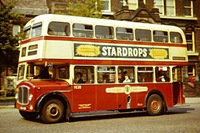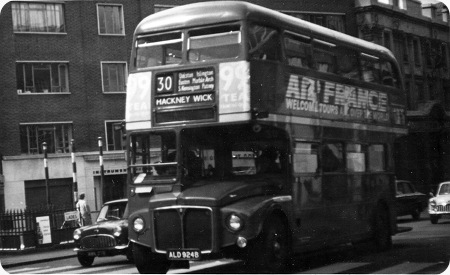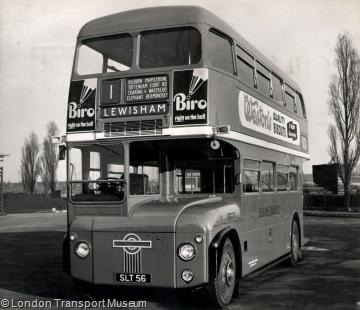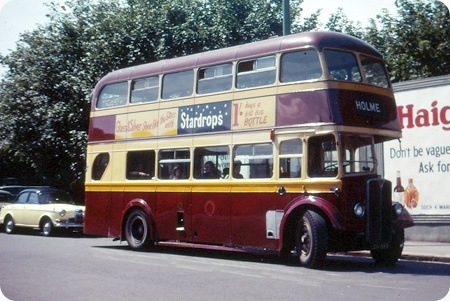St Helens Corporation – AEC Regent V – GDJ 438 – H138
St Helens Corporation
1957
AEC Regent V MD3RV
Weymann H33/28R
The letter in front of the fleet number denotes the transport committees sanctions codes for new vehicles, I think I have seen this before with another operator but who just slips my mind at the time of writing. I am not quite sure as to why it is used unless it is a way of dating the vehicles. The strange thing is that it was only used on their double deckers mind you when this shot was taken in the summer of 64 St Helens corporation only had 4 single deck vehicles. Three AEC Reliance Marshall bodied buses and rather strange for a corporation fleet a Leyland Leopard L2 centre entrance Duple Britannia coach. Not quite sure what that was used for, school children to the swimming pool perhaps or for private hire, they would not of been the first municipality to go down that road.
A full list of Regent V codes can be seen here.
H or L often meant High or Low bridge? Some municipalities would have coaches to take civic parties on tours of inspection- eg the planning committee!
Joe
It’s been said before, and it’s still true. In the right livery, the Orion could be a handsome beast. This is an excellent example. [So is an STD Orion!]
David Oldfield
In this colour scheme, being light on the top half, the whole vehicle looks balanced and attractive. And the rear wheel spats give a touch of class!
Chris Hebbron
Sheffield had the (in)famous 9000 WB, a Reliance/Roe Dalesman C37C – for the use of the Transport Committee but available for Private Hire.
It was alleged that this was bought "because Leeds had one" – but I do not know whether this was true.
Salford had a late (1962) Weymann Fanfare/Reliance which became an airport coach after SELNEC took over. It replaced a Daimler CVD6/Burlingham – both originally committee coaches.
The St Helens Leopard was a 1962 Motor Show exhibit and is pictured in Doug Jack’s book "Leyland Bus".
David Oldfield
You’ve hit the nail squarely on the head David. In the right livery the Orion could indeed be a handsome beast. In this neck of the woods Samuel Ledgard operated four ex-South Wales AEC Regent Vs and an ex-Tyneside Leyland Titan PD2 with such bodies, and they looked a treat in Sammie’s blue and grey livery. The Regents were somewhat spartan inside mind you, but they had the most beautifully raucous exhaust note to compensate. Following Ledgard’s takeover by West Yorkshire in 1967, the AECs were numbered DAW1-4 and later allocated to Harrogate depot. My brother and I would deliberately walk from our usual stop in Bilton, to the one at the top of King Edward’s Drive, just for the sheer pleasure of catching one into town (and obviously back!!). They were generally to be found on the 1/2 Bachelor Gardens-Woodlands and the 9 New Park-Oatlands services, which suited us just fine. At the time I had a morning paper round, and so was also treated to the glorious sound of them barking their way up Bachelor Gardens or the Hill Tops just after seven each morning. Fabulous!
Brendan Smith
DAW 1 – 4 were indeed vehicles full of character Brendan. DAW 2, MCY 408, was the first Ledgard vehicle to be painted in West Yorkshire colours quite soon after the takeover. Along with all the AECs it was initially allocated to Otley and while working the last journey home at 22:35 from Cookridge Street it failed at the Gaumont Cinema (as was). It was taken to Roseville Road and treated to a mechanical wash with a vengeance – being 14’6" inches high it fouled the washing machine and suffered a damaged front roof dome, it was quickly repaired and became the first red "Sammy’s" double decker since G.F.Tate’s WN 4759 in 1943.
Chris Youhill
20/11/11 – 07:30
The Leyland Leopard L2 coach was number 200 (SDJ 162).
On October 9th 1965, I had booked to go, as a Liverpool fan, to Old Trafford to see Liverpool play Manchester United. My friends and I went by bus from Huyton down to Lime Street as we had booked on Crown Tours of Liverpool to get to Old Trafford.
I had a pleasant surprise to find that our coach was SDJ 162, on hire to Crown. However we lost 2-0 to goals from Best and Law, so the coach remained the highlight of the day.
It was later part exchanged against Bedford VAM 201 (KKU 77F) and was not traced after that.
Dave Farrier
20/11/11 – 13:35
David Oldfield mentions above the fact that Sheffield had a coach because Leeds had one. Leeds first coach was a 1965 AEC Reliance with a Roe body based on the Roe bodied AEC Reliance service buses bought at around the same time It was numbered 10 ANW 710C and was bought for private hire it went into preservation but its current whereabouts are unknown. Just before the PTE took over a trio of Plaxton bodied Leyland Leopards were also purchased numbered 21-23 MUG 21L etc
Chris Hough
20/11/11 – 14:44
Chris. How interesting – since the Sheffield one predated your Leeds one by about seven years. The story mangled the facts a bit, evidently.
As a matter of fact, I actually drove 10 when it was owned by Classic Coaches of High Wycombe on a private hire from Reading to Lord’s Cricket Ground, London, and back.
It was of Classics original fleet of four (including a West Riding Dalesman, a "Brown Bomber" Harrington and a Royal Blue MW/ECW). Mr Crowther then grew too quickly and went pop – after which I lost track of his vehicles. A lot of the interesting ones found further homes in preservation – it is to be hoped that the three Reliances above were among them.
David Oldfield
22/11/11 – 07:27
David This posting proves what a small world it is! I went to secondary school with David Crowther and later worked with his wife. Like many enthusiasts I think he let his heart rule his head despite training as an accountant
Chris Hough
22/11/11 – 09:16
Small world indeed. A very nice man – but not a successful operator – but I know a number of "professional" operators who would fit this bill as well. [I also know a number of the latter who run the ship with military precision but are thoroughly unpleasant people to work for!]
PS David had a cracking pair of Leyland engined REs as well!
David Oldfield
13/07/12 – 06:10
I went to school on this vehicle. If I remember I think the Letter in the fleet number was related to the registration number. A DDJ bus would be D### and K199 was a KDJ registration.
Geoff Atherton
14/07/12 – 18:09
To pick up a point raised in the original post, about "sanction codes" in front of fleet-numbers: the ten AEC Regent Vs delivered to Bradford Corporation Transport in November 1962 (126-135) carried the code "A" – they were the only vehicles so to do. These vehicles had been ordered in March 1961. John Wake, GM at St. Helen’s, had been appointed GM at Bradford in March 1961 . . . but left for Nottingham in July 1962. This innovation didn’t survive beyond his departure – although the St. Helens-style three piece destination layout did, and the earlier Regent Vs (106-125) were converted to this layout. I gather, from J S King’s excellent three-volume history of BCT, that John Wake didn’t stay long at BCT because his anti-trolleybus views put him in conflict with a good proportion of the Transport Committee . . . although that didn’t, during his short tenure, stop him pushing through the agreement in committee that led to the final decision to decommission the trolleybus operations.
Philip Rushworth
05/08/12 – 07:24
Re the comment from Geoff Atherton, St Helens K199, Reg No. KDJ 999 was an experimental Regent V front entrance bus bought in lieu of the fact that Leyland could not supply Atlanteans. She was unique to the Corporation and as far as I can remember had the nickname "Big Bertha". She ended up on the 309 service from Burtonwood to Southport, but had a habit of running out of diesel on route. Apparently, whilst on charter to Blackburn, she also dropped part of her engine on the nearside lane of the M6! As far as I am aware, she is still extant in the North West Transport Museum in St Helens.
Alan Blincow
22/08/12 – 14:58
St Helens Corporation had a kind of year letter system but it was only briefly used on double deckers. Some had the letter stencilled internally, others didn’t. Some had just the fleet number at the front of the bus, others didn’t.
It was only used between 1954 and 1966, the final six Leyland Titan PD2As and three AEC Regents (1967) were just 50-58.
Letters A-D were retrospectively applied, A being pre-1945, B were 1945-47, C 1948. The London specification AEC Regent RT types were given letter D. Sanction E was the first to be applied new, to Leyland Titan PD2s (1954/5), F (1955/6), G (1956). H, J and K were AEC Regent Vs of 1957-59 and the first "St Helens bonnet" Leyland PD2As of 1960. Letter L applied to AEC Regent Vs and Leyland PD2As built in 1961/62. L was used for the 1965 Leyland PD2As instead of M, but these had year-letter registrations and the corporation decided that with future new buses having year letter registrations the fleet number prefix was no longer necessary so it was dropped. However many of the L prefixed buses carried them internally until withdrawal in Merseyside PTE days in the late 1970s.
Paul Mason
25/05/13 – 08:34
Re Alan Blincows post…
K199 was used on the 309-319 services between Warrington and Southport extensively between 1963 and 1967 and most certainly didn’t run out of fuel on the ‘last Southport’!!!. The tank was more than ample for any duty that the Corporation ran.
I think you are referring to an article in Mervyn Ashtons otherwise excellent book on St Helens Transport…. Let’s just say that Mervyn was using a little ‘poetic licence’ at times!!!.
I bought Big Bertha from Tom Hollis at Queensferry in June 1978, and later sold her on to Ray Henton at the North West Transport Museum, where she still resides…
Roy Corless
24/08/14 – 10:39
Yesterday I did a wedding hire with ex St Helens AEC Regent V/MCW bus no 58. A warning in the cab says Unlaiden height 14ft 3 1/2in . So this must have been the standard for the corporation till the last half cabs were delivered
Geoff S
04/08/16 – 11:12
Does anybody know if St Helens K199 (Big Bertha) had any work done on it?
John M
01/12/16 – 06:54
In reply to your inquiry K199 has had a clutch slave cylinder replaced, But the master also needs work. This will be done sometime in 2017 to enable the bus to be moved around the museum more easily.
The sides of the bus are Bulging so work is required to the main body.
John P
27/05/17 – 07:33
Update on St.Helens K199 (KDJ 999) Big Bertha.
The clutch hydraulics have now been sorted and the engine started for the first time in 15yrs.
It still resides at the North West Transport Museum in St.Helens, there is going to be a show next year at the town hall square where it is hoped K199 will be on display.
John P
02/05/18 – 07:50
Does any one know if Big Bertha k199 is running yet?
John M
 Vehicle reminder shot for this posting
Vehicle reminder shot for this posting
10/06/18 – 08:45
Yes it is running but unfortunately it cannot be extricated from the position it is in at the museum but the interior has been completely repainted on the lower deck to the standard of what it was when it was in service with St. Helens.
Norman Johnstone
Quick links to the - Comments Page - Contact Page - Home Page




